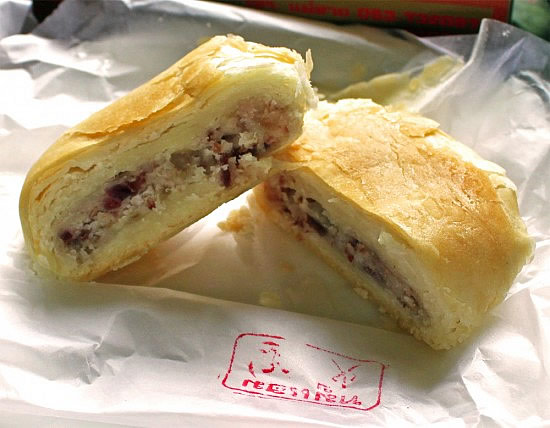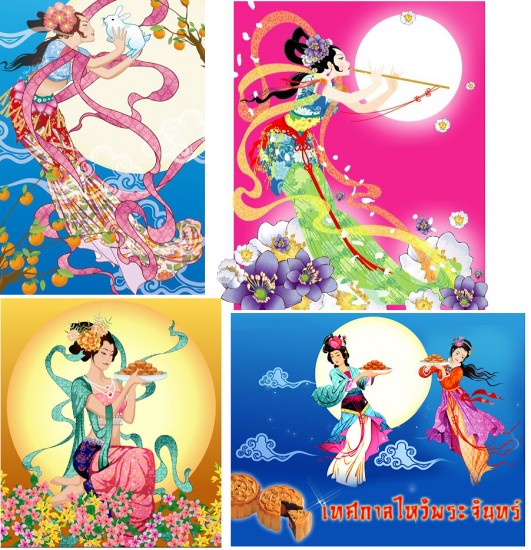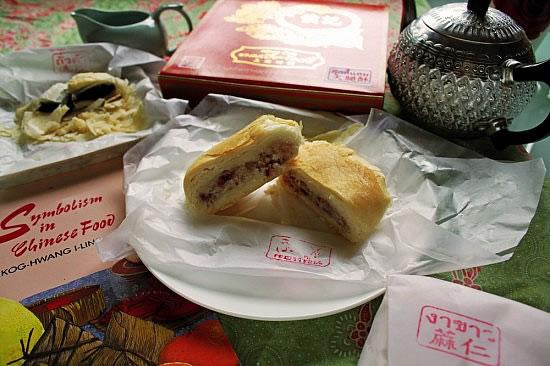Chinese Moon Cakes & the Lady in the Moon
The Chinese Mid-Autumn Moon Festival (เทศกาลไหว้พระจันทร์ wan wai phra jan in Thai), also known as the Moon Cake Festival, takes place on the 15th day of the eighth month in the Chinese Lunar Calendar. On this full moon, close to the autumnal equinox, the moon is said to be at its fullest and roundest. This marks the end of the harvest period and the moon cake festival probably began as a celebration for this time of plenty. This festival is held everywhere in the world where there is a large Chinese community, and Thailand is no exception. In Bangkok, celebrations take place along Yaworat Road, the heart of Chinatown; in the South, in Phuket’s Old Town; and in North in Chiang Mai, the best place to observe the festivities is at the Pung Tao Gong Chinese Ancestral Temple near Warorot Market (kad luang in Thai).
During the festivities, the Chinese pray to Chang’e, also known as the lady in the moon. There are several versions of the ancient myth about how Chang’e became a lunar goddess. Chang’e was the wife of Hou Yi the Archer, who was called by the Emperor to save the earth with his bow and arrows. The scorching heat of ten suns, which at that time appeared together, threatened the earth. Hou Yi shot down nine suns, leaving one and in reward, the Emperor gave Hou Yi the elixir of life, instructing him to fast for one year to prepare to take it. But his wife Chang’e discovered the elixir and took it herself. Hou Yi found her and soon realized what had happened when his wife could suddenly fly. To escape his wrath she flew to the moon and has lived there every since!
Legend has it that moon cakes originated in the Yuan dynasty. At that time, the Chinese people were oppressed under the tyrannical rule of their Emperor causing a peasant leader to organize a revolt on the day of the mid-autumn festival. To build support, secret messages were hidden in the moon cakes. Because moon cakes are sold in packages of four and with each cake cut into four pieces, the sixteen segments could be re-arranged so that the marks on the crust revealed a coded message. Then the evidence was eaten! The peasants were able to successfully rebel against their Mongol rulers and later founded the Ming Dynasty; therefore, this festival also commemorates the overthrow of Mongolian rule by the Han Chinese.
There are many different types of moon cakes, with various doughs and fillings. The ones pictured here are Yunnan style moon cakes. The pastry is similar to Teochew moon cakes which have flaky biscuit skins and are usually round and somewhat flat, unlike Cantonese moon cakes, which are perhaps more well known in North America (imprinted with a raised Chinese character). Our moon cakes were made by a Chinese bakery in Mae Sai (แม่สาย), which is the northern-most village in Thailand, on the border with Burma. There were 3 types of moon cakes to choose from: white sesame seed, black sesame seed and as shown, Yunnanese ham filled, which is perhaps not so typical.
We enjoyed our Moon Cakes served with hot green Chinese tea. We are already looking forward to the celebration next year, now that we know a little of the history behind this pastry. Look for Moon Cakes in your own area – even a local Chinese restaurant may be selling them, as this is one of the most important and symbolic foods for Chinese people.
Sources: Symbolism in Chinese Food; copyright 1991, Kog-Hwang I-Ling; Publisher Graham Brash (Pte) Ptd, Singapore; ChiangMaiBest.com and various Wikipedia entries.







No Comments on "Chinese Moon Cakes & the Lady in the Moon"